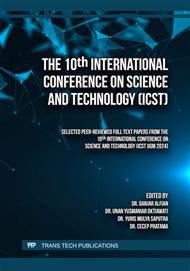[1]
C. J. Ho, Y. J. Hsieh, S. Rashidi, Y. Orooji, and W. M. Yan, "Thermalhydraulic analysis for alumina/water nanofluid inside a mini-channel heat sink with latent heat cooling ceiling-An experimental study," Int. Commun. Heat Mass Transf., vol. 112, no. January, 2020.
DOI: 10.1016/j.icheatmasstransfer.2020.104477
Google Scholar
[2]
Y. Wang, B. Wang, K. Zhu, H. Li, W. He, and S. Liu, "Energy saving potential of using heat pipes for CPU cooling," Appl. Therm. Eng., vol. 143, no. January, p.630–638, 2018.
DOI: 10.1016/j.applthermaleng.2018.07.132
Google Scholar
[3]
K. Sefiane and A. Koşar, "Prospects of heat transfer approaches to dissipate high heat fluxes: Opportunities and challenges," Appl. Therm. Eng., vol. 215, no. June, 2022.
DOI: 10.1016/j.applthermaleng.2022.118990
Google Scholar
[4]
L. Ding, X. Cai, R. Xia, and F. Zhao, "A simplified over-temperature protection structure for smart power ICs," Analog Integr. Circuits Signal Process., vol. 111, no. 3, p.451–460, 2022, doi: 10.1007/s10470-022- 02029-8.
DOI: 10.1007/s10470-022-02029-8
Google Scholar
[5]
A. Arshad, S. A. Iqrar, S. C. Costa Pereira, M. W. Shahzad, K. Nawaz, and W. Worek, "Cooling performance of an active-passive hybrid composite phase change material (HcPCM) finned heat sink: Constant operating mode," Int. J. Heat Mass Transf., vol. 207, p.123973, 2023.
DOI: 10.1016/j.ijheatmasstransfer.2023.123973
Google Scholar
[6]
K. C, P. C. Mukeshkumar, and A. K. Arun, "Numerical study on the performance of Al2O3/water nanofluids as a coolant in the fin channel heat sink for an electronic device cooling," Mater. Today Proc., no. xxxx, 2023.
DOI: 10.1016/j.matpr.2023.02.337
Google Scholar
[7]
Y. M. Chu et al., "CFD analysis of hybrid nanofluid-based microchannel heat sink for electronic chips cooling: Applications in nano-energy thermal devices," Case Stud. Therm. Eng., vol. 44, no. February, p.102818, 2023.
DOI: 10.1016/j.csite.2023.102818
Google Scholar
[8]
A. Naufal bin Samsudin, A. Salami Tijani, S. Thottathil Abdulrahman, J. Kubenthiran, and I. Kolawole Muritala, "Thermal-hydraulic modeling of heat sink under force convection: Investigating the effect of wings on new designs," Alexandria Eng. J., vol. 65, p.709–730, 2023.
DOI: 10.1016/j.aej.2022.10.045
Google Scholar
[9]
S. Siahchehrehghadikolaei, M. Gholinia, S. S. Ghadikolaei, and C. X. Lin, "A CFD modeling of CPU cooling by eco-friendly nanofluid and fin heat sink passive cooling techniques," Adv. Powder Technol., vol. 33, no. 11, p.103813, 2022.
DOI: 10.1016/j.apt.2022.103813
Google Scholar
[10]
A. A. Sertkaya, M. Ozdemir, and E. Canli, "Effects of pin fin height, spacing and orientation to natural convection heat transfer for inline pin fin and plate heat sinks by experimental investigation," Int. J. Heat Mass Transf., vol. 177, p.121527, 2021.
DOI: 10.1016/j.ijheatmasstransfer.2021.121527
Google Scholar
[11]
R. A. Nicholls, M. A. Moghimi, and A. L. Griffiths, "Impact of fin type and orientation on performance of phase change material-based double pipe thermal energy storage," J. Energy Storage, vol. 50, no. March, p.104671, 2022.
DOI: 10.1016/j.est.2022.104671
Google Scholar
[12]
B. İ. Toprak, S. Baghaei Oskouei, Ö. Bayer, and İ. Solmaz, "Experimental and numerical investigation of a novel pipe-network mini channel heatsink," Int. Commun. Heat Mass Transf., vol. 136, 2022.
DOI: 10.1016/j.icheatmasstransfer.2022.106212
Google Scholar
[13]
S. Thiangchanta, R. Khiewwijit, S. Chainetr, and Y. Mona, "Energy reduction for commercial freezer by force convection cooling of heatsink," Energy Reports, vol. 8, p.394–399, 2022.
DOI: 10.1016/j.egyr.2022.05.169
Google Scholar
[14]
A. Chamkha, A. Veismoradi, M. Ghalambaz, and P. Talebizadehsardari, "Phase change heat transfer in an L-shape heatsink occupied with paraffin-copper metal foam," Appl. Therm. Eng., vol. 177, no. April, p.115493, 2020.
DOI: 10.1016/j.applthermaleng.2020.115493
Google Scholar
[15]
D. X. Zhang et al., "Design and the transient thermal control performance analysis of a novel PCM-based active-passive cooling heat sink," Appl. Therm. Eng., vol. 220, no. September 2022, p.119525, 2023.
DOI: 10.1016/j.applthermaleng.2022.119525
Google Scholar
[16]
F. Alawwa et al., "Thermohydraulic performance comparison of 3D printed circuit heatsinks with conventional integral fin heatsinks," Appl. Therm. Eng., vol. 226, no. October 2022, p.120356, 2023.
DOI: 10.1016/j.applthermaleng.2023.120356
Google Scholar
[17]
S. Sulung, A. K. Mainil, and A. Suandi, "Heatsink 3D By Cfd Analysis of Cooling System in a Pc Desktop," Rekayasa Mek. Mech. Eng. Sci. Journal, Pure Inter Discip., vol. 3, no. 2, p.20–25, 2019, [Online]. Available: https://ejournal.unib.ac.id/index.php/rekayasamekanika/article/view/98 56
Google Scholar
[18]
J. G. Hernandez-Perez, J. G. Carrillo, A. Bassam, M. Flota-Banuelos, and L. D. Patino-Lopez, "A new passive PV heatsink design to reduce efficiency losses: A computational and experimental evaluation," Renew. Energy, vol. 147, p.1209–1220, 2020.
DOI: 10.1016/j.renene.2019.09.088
Google Scholar
[19]
W. Zhao, Z. Ying, X. Song, and R. Xu, "Cost-minimization method for heatsink of multi-parallel power devices considering thermal safety constraints," Energy Reports, vol. 7, p.306–314, 2021.
DOI: 10.1016/j.egyr.2021.10.028
Google Scholar
[20]
G. N. Shilo, E. V. Ogrenich, and N. P. Gaponenko, "Design of finned heatsinks having minimum mass," Mod. Probl. Radio Eng. Telecommun. Comput. Sci. - Proc. 10th Int. Conf. TCSET'2010, no. 5, p.301–302, 2010.
Google Scholar


